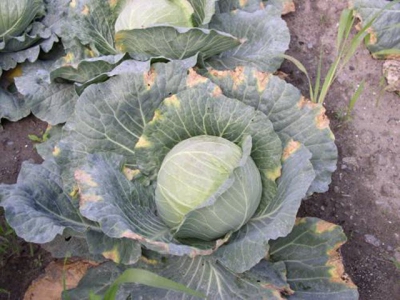Cabbage disease black rot

Black rot (Xanthomonas campestris) is the most important cabbage disease. Thriving in warm, wet conditions, it is most active at 25°C to 30°C and therefore more of a problem in late summer.
A strain of black rot that comes and goes according to weather conditions.
It is caused by a bacterium and cannot be treated by any current product. Symptoms usually start at the leaf edges: conspicuous V-shaped, yellow lesions develop as the bacteria move further into the leaf. If you snap the leaf just below one of these lesions, you will notice a blackening within the vein. The disease is systemic and eventually spreads to most of the plant.
Many farmers spray copper-based products to prevent the disease or slow its spread. This simply does not work. I have carried out many trials and found no difference between sprayed and unsprayed areas. Farmers would do far better by trying to understand the disease.
For one thing, a cabbage leaf has pores (or vein openings) called hydathodes along its edge. In wet, humid conditions, water pressure from within the plant causes drops of sap to be exuded from these pores. When the weather warms up, the sap is sucked back into the leaf together with any airborne bacteria that has landed on it. Although copper kills bacteria, the concentration of copper in each droplet is far too low to kill the bacteria.
I have seen farmers cause burn on the crop by increasing the copper concentration in a futile effort to control the disease. The bacteria can also enter the plant through wounds caused by caterpillars and hail. In the latter case, applying a copper spray immediately after the hail might do some good, as the bacteria can enter through the open wounds. It also means that you should not have any diamond back moth larvae on the crop when black rot conditions are present.
Control measures that work
Ultimately, the most effective control measure is to plant resistant varieties. They don’t provide total immunity, but will usually reduce the level of infection to a manageable level. I say ‘usually’, because resistance to bacteria trying to invade the plant through the hydathodes is stronger. It is less effective with open wounds on the leaves, especially at higher temperatures.
The fact that there are differing forms of black rot further complicates the process of promoting resistance. Researchers around the world are testing for resistant genes in every brassica in the family in order to incorporate these into cabbage breeding lines. This process will take some years. Most books on the subject claim that crop rotation will help control black rot, but this has not been my experience. If conditions are right and the cultivar is susceptible, black rot will occur even with heat-treated seed in virgin soil.
On the other hand, it will spread faster when planted near infected plants, as the concentration of bacteria in the air will be higher. Wet patches on the land are also good starting points for the bacteria.
Increasing the gap between plants
Another strain of X. campestris occurs sporadically in very wet, warm conditions and stops developing when these conditions change. It does not enter through the hydathodes, but the usual signs will appear on the leaves. Many a farmer will panic on spotting this, then be surprised when the symptoms simply stop.
If you farm in an area where black rot is a greater hazard, avoid planting late-maturing varieties and widen the spacing.
In addition, you can increase the gap between plants to allow a better movement of air and a slightly dryer microclimate. This will also bring the crop to harvest earlier, which will help to further reduce the danger of black rot. The heads can be harvested before the black rot spreads from the outer leaves to the head and cover leaves. This can sometimes mean the difference between success and severe damage.
Related news
 Dealing with aphids on brassicas
Dealing with aphids on brassicas Aphids are a problem in two ways. Firstly, they cause physical damage when feeding on the crop.
 Sporadic, yet serious, cabbage pests
Sporadic, yet serious, cabbage pests Several cabbage pests may be sporadic or seasonal. One of these is thrips.
 More sporadic cabbage pests
More sporadic cabbage pests Before we start on cabbage diseases, there are still a few sporadic pests that we should look at. One is the cabbage webworm (Hellula undalis).